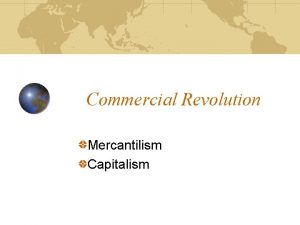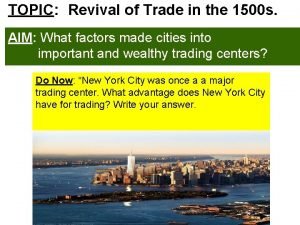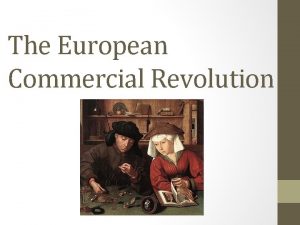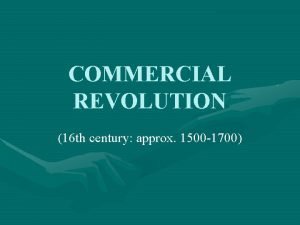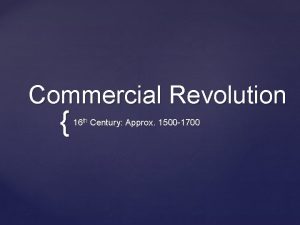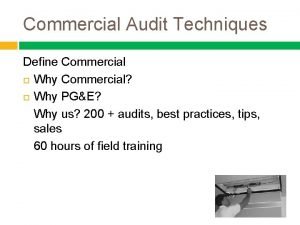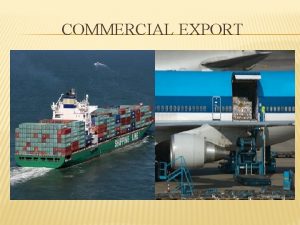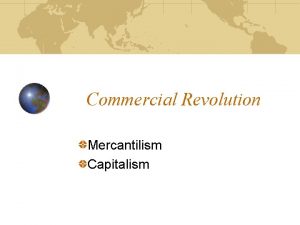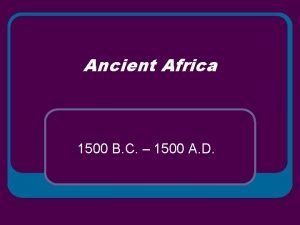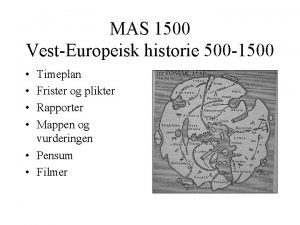Chapter 15 Part 7 The Commercial Revolution 1500



















- Slides: 19

Chapter 15 Part 7 The Commercial Revolution 1500 -1700

Causes of the Commercial Revolution n Roots: The Hanseatic League n Population Growth = more consumers 1500… 70 million n 1600… 90 million n n Price Revolution: long, slow upward trend in prices Increased food prices n Increased volume of money n Higher prices = increase in supply n

Nation States n Tried to increase economic power

Rise in Capitalism Laissez-faire capitalism n Entrepreneurs n Bourgeoisie at the forefront n

Features of the Commercial Revolution Banking: n The Medici in Italy n The Fuggers in Germany n Funded all kinds of economic activity n 16 th Century: Antwerp: Europe’s banking and commercial center n 17 th Century: Amsterdam (after Dutch revolt when Antwerp was destroyed) n

The Hanseatic League Middle Ages to 16 th Century n Controlled trade in much of Northern Europe n Was a mercantile association of many German cities and towns

Chartered Companies n The State provided monopolies British East India Co. n Dutch East India Co. n n Often had fleets of ships and military and governmental powers

Joint Stock Companies n Groups of investors who pooled resources for a common venture London Co. n Plymouth Co. n Forerunners of modern corporations n Early examples of capitalism n

Stock Markets n The Bourse in Antwerp Investors purchased shares of stock n Then, as value of the company grew, so did the value of the stock n n So…investors realized a profit

The First Enclosure Movement n England Enclosed land for sheep herding and wool production n More profitable than growing food n n But food prices went up because there was less of it!

The Emergence of Cottage Industries The “Putting Out” system n Cottagers were often farmers who lost their livelihood due to the enclosure movement began to produce goods at home and sold them to merchant capitalists n First for cloth production: spinning and weaving n Then household goods: buttons, musical instruments, printing, muskets, etc. n

New Consumer goods n Sugar, rice, etc

Mercantilism 17 th Century n To the self-sufficiency of the nation Favorable balance of trade n Bullionism n Promote internal industries n Lure skilled workers into one’s country n Colonies for resources and markets for surplus goods n

The Commercial Revolution n Slowly transformed Europe from an isolated rural society to a more developed urban society n Serfs in Western Europe were able to improve their social status Since wealth could be taxed, it led to powerful nation-states n Could now finance voyages of discovery n

The Price Revolution Part of the Commercial Revolution n Rising population = rising demand = rising prices n n Gold and silver from the New World was partially responsible

The Price Revolution n Inflation stimulated production because producers got “more” money for their products Peasants benefitted when surplus became cash crops n Bourgeoisie made their money through trade and manufacturing so they could increase their social and political status n

BUT The Nobility (of the Sword) did NOT benefit from inflation n They were stuck with fixed incomes from feudal rents and their standard of living diminished over time n n The Bourgeoisie grew in political and economic significance

The Bourgeoisie were doing very well First in the Italian city-states n Was the most powerful class in the Netherlands n In France, their political power grew at the expense of the nobility n More and more influence in English politics n

The Commercial Revolution Results: n Most in Western Europe saw an increased standard of living n Especially the middle class n There was more food, a greater variety of food, the same goes for household utensils
 Non commercial foodservice
Non commercial foodservice The commercial revolution
The commercial revolution Mercantilism and commercial revolution
Mercantilism and commercial revolution Commercial revolution
Commercial revolution Commercial revolution
Commercial revolution Russian revolution vs french revolution
Russian revolution vs french revolution How could the french revolution been avoided
How could the french revolution been avoided The third agricultural revolution
The third agricultural revolution Hình ảnh bộ gõ cơ thể búng tay
Hình ảnh bộ gõ cơ thể búng tay Lp html
Lp html Bổ thể
Bổ thể Tỉ lệ cơ thể trẻ em
Tỉ lệ cơ thể trẻ em Chó sói
Chó sói Tư thế worm breton
Tư thế worm breton Alleluia hat len nguoi oi
Alleluia hat len nguoi oi Môn thể thao bắt đầu bằng chữ đua
Môn thể thao bắt đầu bằng chữ đua Thế nào là hệ số cao nhất
Thế nào là hệ số cao nhất Các châu lục và đại dương trên thế giới
Các châu lục và đại dương trên thế giới Công thức tính thế năng
Công thức tính thế năng Trời xanh đây là của chúng ta thể thơ
Trời xanh đây là của chúng ta thể thơ


